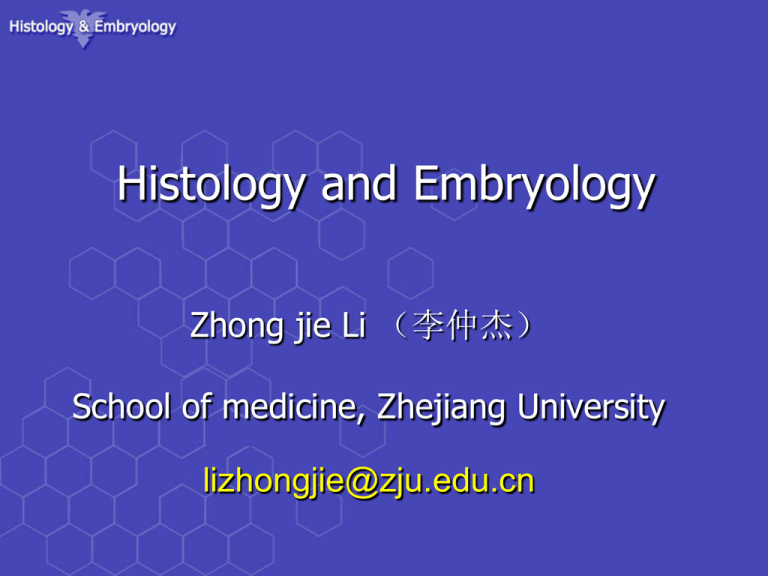Chapter 2 Epithelium
advertisement

Histology and Embryology Zhong jie Li (李仲杰) School of medicine, Zhejiang University lizhongjie@zju.edu.cn Chapter 1 Introduction Relationship: cell --- tissue---organ---system---human body Key points: I. What’s histology? II. Why we study it ? III. How to study it ? ---Histological methods. I. What’s histology? Histology (Greek words): /histo---tissue /logia---study of ,or knowledge of Histology means the knowledge of tissue, is a branch of Anatomy. Anatomy: ---gross anatomy ---microscopic anatomy/microanatomy Histology : a science which study the microstructure and the relationship between the structure and function of human being. Cell: smallest unit of structure and function of body Tissue: group of cell and extracellular matrix Four basic tissue: ---Epithelial tissue ---Connective tissue ---Muscular tissue ---Nervous tissue Organ: made up of tissue, have special shape, structure and function --- the cavity organ histology --- parenchymatous organ anatomy System: organs which have related function get together. What’s Embryology? Embryology is a kind of science which study the processes and the regulations of the development of human fetus. --- Preembryonic period --- Embryonic period (8 weeks before) --- Fetal period (9-38 weeks) II. Why medical students should study Histology ? Graduate Intern (exercitation) Clinic (Medicine,Surgery,Gynecology, Pedology, Pathphysiology Physiology Pharmocology etc.) Basic medicine &Surgery BiochemistryParasitology Patholo gy Histology & Embryology Microbiology Immunology Anatomy III. How to study it • Microscopy: Light microscopy (LM) Electron microscopy (EM) • Transmission electron microscope (TEM) • Scanning electron microscope (SEM) • Staining: H&E Histochemistry Immunohistochemistry In situ hybridiztion … Relative Sizes in Histology Standard Units of Measure Light Microscopy :The resolution of the human eye is 0.2 mm. :The resolution of the light microscope is 0.2 um. : The resolution of the light microscope is 0.2 nm. Preparation of tissue for LM The most routine one is paraffin section stained with hematoxylin and eosin(H&E) The steps: a. Obtaining the specimen: fresh, small pieces tissue block( less than 5mm3) b. Fixation: fixatives: use formalin or Bouin’s to preserve structural organization c. Dehydration: use ethyl alcohol to get rid of water of tissue and cell d. Clearing: use xylene to get rid of alcohol *alcohol and xylene are embedding mediums e. Embedding: firstly, heat the paraffin, make it melt, then put tissue block into melted paraffin, allow paraffin harden, the tissue block is embedded in. f. Sectioning: use microtome to cut the tissue into 3-8um thick sections, then mounted them on glass slides g. Staining H&E --- Routine staining for LM ---Hematoxylin: basic dye, combines with acidic components, make them appear blue colour- basophilic, i.e. cell nucleus, hyaline cartilage ---Eosin: acidic dye, combines with basic components, make them appear pink colour- acidophilic (eosinophilic), i.e. cytoplasm nucleolus • basophilic • acidophilic (eosinopilic) • neutrophilc nucleus H&E staining TEM: transmission electron microscopy The resolution of the TEM is about 0.1-0.5nm. Basophilic granulocyte (TEM) Basophilic granulocyte (LM) SEM: scanning electron microscopy The resolution of SEM is about 5nm. Histochemistry & Cytochemistry To combine histological and cytological methods with chemical and biochemical methods and reveal the chemical composition of tissue and cell in situ. Periodic acid-Schiff (PAS) reaction Localize polysaccharides, such as glycogen, in tissues and cells. PAS+ Produce an insoluble magenta complex Immnohistochemistry To use labelled antibodies as specific reagents for localizing tissue and cell constituents (antigens) in situ Observation:Fluorescence microscope In Situ Hybridization • A method for detection of specific RNA or DNA sequences directly in cells or tissue sections • incubate tissues with probe to detect cells expressing gene Methods of learning: ---Must think in 3 dimensions ---Structure and function ---part and whole. oblique section Horizontal section longitudinal section Structure and function Part and whole 舒张状态 收缩状态 Reference books • 1. Jun min T, Ji cheng L. Textbook of Histology and Embryology. Peking University Medical Press, 2011 • 2. William k. Ovalle & Patrick C. Nahirney. Netter’s essential histology, Elsevier Health Sciences,2007 • 3. Gaetner MP, Hlatt JL. Colour Textbook of Histology. Williams & Wilkins, 1997 Course web: http:/m-learning.zju.edu.cn (2015 Histology and Embryology) The composition of final score: 1. Lecture and Lab attendence: 10 % 2. Quiz: 15% (each quiz 5%) 3. Lab test: 25% 4. Final written examination:50% Histology: 35-40% Embryology:10-15% *. If you want to pass this course, final written examination score must be more than 50. Preparation of laboratory work Have the tools ready: 1) Pencils (red-blue pencil) 2) rubber, ruler and so on









